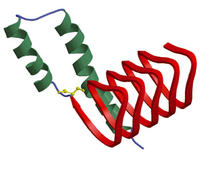-
Inovio Pharmaceuticals gets DoD continuation grant for synthetic DNA vaccine delivery device
The U.S. Department of Defense has given a Small Business Innovation Research grant to Inovio Pharmaceuticals to continue developing a low-cost, non-invasive surface electroporation (EP) delivery device; the testing of the device in conjunction with Inovio’s synthetic DNA vaccines against viruses with bioterrorism potential, including hanta, puumala, arenavirus and pandemic influenza
-
-
Detection technology detects viruses, pathogens within 24 hours
New detection technology could enable food safety professionals, law enforcement, medical professionals, and others to detect within twenty-four hours any virus or bacteria that has been sequenced and included among the array’s probes
-
-
Two RNA-based therapeutic candidates for Ebola, Marburg viruses
Under a contract for up to $291 million from the U.S. Department of Defense, AVI BioPharma has initiated clinical studies for two RNA-based drugs for the treatment of Ebola and Marburg viruses
-
-
Army scientists work to improve biothreat detection
A married couple, both scientists working at the U.S. Army’s Edgewood Chemical Biological Center, one of forty-five Biosafety Level 3 labs in the United States; they collaborate on improving the ability of soldiers and first responders to detect, identify, and protect against potentially lethal biological threat agents
-
-
Antibiotic-resistant bacteria proliferate in agricultural soils
Infectious diseases kill roughly thirteen million people worldwide, annually, a toll that continues to rise, aided and abetted by resistance genes. Now a study finds reservoirs of resistance in agricultural soils
-
-
Hospital fountains a dangerous source of bacterial outbreaks

A recent study conducted by researchers at the Wisconsin Division of Public Health found that fountains in health care facilities can actually be a dangerous source of air-borne bacterial diseases; “Fountains and health-care facilities don’t mix,” said Thomas Haupt, a respiratory diseases epidemiologist and the study’s lead author
-
-
Solving antibiotic resistance in humans -- and premature bee death
The stomachs of wild honey bees are full of healthy lactic acid bacteria that can fight bacterial infections in both bees and humans; the finding is a step toward solving the problems of both bee deaths and antibiotic resistance in humans
-
-
Balancing safety, risk in the debate over the new H5N1 viruses
This fall, the U.S. National Science Advisory Board for Biosecurity (NSABB) set off a debate when it asked the authors of two recent H5N1 research studies and the scientific journals that planned to publish them to withhold important details of the research in the interest of biosecurity; the scientific community is divided over the issue of best to balance free research and security
-
-
CDC study finds raw milk is most likely source of dairy outbreaks
A new study by the Centers for Disease Control and Prevention (CDC) finds thatraw milk is 150 times more likely to be the cause offood-borne illnesses than pasteurized milk; a growing number of states have permitted the sale of raw milk
-
-
Anthrax-decontamination foam used in meth lab cleanup
The meth cleanup problem in the United States is a big one; the U.S. Drug Enforcement Administration lists thousands of locations where law enforcement agencies have found chemicals or paraphernalia indicating the presence of either clandestine drug laboratories or dumpsites; Sandia’s decontamination foam, originally developed to deal with anthrax, is now also a meth eraser
-
-
Cell phone-based sensor detects E. coli
Researchers have developed a new cell phone-based fluorescent imaging and sensing platform that can detect the presence of the bacterium Escherichia coli in food and water
-
-
Thwarting the botulinum neurotoxin
The botulinum neurotoxin is the most poisonous substance known to man, causing botulism; it can be used by terrorists for deadly attacks; the toxin paralyzes muscle cells by disrupting their connections with the nerves that tell them how and when to move
-
-
Drug-resistant MRSA in livestock now infects humans
A novel form of MRSA, a methicillin-resistant Staphylococcus aureus called ST398, can now be found in pigs, turkeys, cattle, and other livestock and has been detected in 47 percent of meat samples in the United States; the figures illustrate a very close link between antibiotic use on the farm and potentially lethal human infections
-
-
U.S. extends zero tolerance policy to six additional E.Coli serogroups
The U.S. Department of Agriculture has taken additional steps to fight E. coli in the food supply; the new policy adds six E. coli serogroups to the list of sergroups which are not allowed to be present in raw ground beef or the meat used to make raw ground beef; the beef industry says it will be too expensive to implement, and U.S. trading partners said preventing their beef from entering the U.S. unless tested for the six serogroups would violate existing trade agreement
-
-
Using ozone to kill prions dead

Prions are among the worst infectious-disease agents; these proteins are resistant to a wide variety of extreme disinfectant procedures; they have been identified as the culprits behind mad cow disease and chronic wasting disease in animals and humans, and are also implicated in Creutzfeldt-Jakob disease and other prion-related disorders
-
- All
- Regional
- Water
- Biometrics
- Borders/Immig
- Business
- Cybersecurity
- Detection
- Disasters
- Government
- Infrastructure
- International
- Public health
- Public Safety
- Communication interoperabillity
- Emergency services
- Emergency medical services
- Fire
- First response
- IEDs
- Law Enforcement
- Law Enforcement Technology
- Military technology
- Nonlethal weapons
- Nuclear weapons
- Personal protection equipment
- Police
- Notification /alert systems
- Situational awareness
- Weapons systems
- Sci-Tech
- Sector Reports
- Surveillance
- Transportation
Advertising & Marketing: advertise@newswirepubs.com
Editorial: editor@newswirepubs.com
General: info@newswirepubs.com
2010-2011 © News Wire Publications, LLC News Wire Publications, LLC
220 Old Country Road | Suite 200 | Mineola | New York | 11501
Permissions and Policies
Editorial: editor@newswirepubs.com
General: info@newswirepubs.com
2010-2011 © News Wire Publications, LLC News Wire Publications, LLC
220 Old Country Road | Suite 200 | Mineola | New York | 11501
Permissions and Policies
